Cultural Fabric
The lifestyle brand’s first location was nothing more than a busy intersection that connected the posh neighbourhoods of Breach Candy, Malabar Hill and Altamount Road. It wasn’t in historic Fort, Lower Parel was a distant dream and Bandra an even more distant suburb. With price points that made many balk, Good Earth took some getting used to. Somehow, it dared to create its own niche in a recently liberalised market and ran with the firm belief ‘If you build it, they will come’. And, sure enough, they did.
A student of art history — her master’s dissertation explored the global impact of Indian chintz — Lal went on to major in product development and merchandising at Fashion Institute of Technology in New York. Armed with insights and a brief stint at a homewares label, she officially joined Good Earth about 15 years ago. For guidance, Lal didn’t have to look farther than her mother. “She is an excellent problem solver. It is from her that I learnt to look at things from a different perspective. For her, every shut door is an opportunity to look for a new one. She is positive, generous and creative.” While the two share the same passion and commitment to their company and its future, where they possibly differ, Lal finds, “is in our working styles — she is more spontaneous and impulsive. And in my role as a CEO, I have to be more measured. Every decision has to be thought through, discussed and evaluated. I had to train myself to think this way because I am also first a creative person.”
A “game changer” for Good Earth was setting up its flagship store in 2005 in a sprawling 20,000-square-foot defunct textile repository at Raghuvanshi Mills in Lower Parel. With the addition of multiple stores in Mumbai, Delhi, Bengaluru, Hyderabad, Chennai and Jaipur (as well as two outposts in Turkey), the brand needs no introduction today, and has become synonymous with Indian luxury and fine craftsmanship long before it was on-trend.
Two decades and many milestones — including sponsoring The Fabric of India exhibit at London’s V&A in 2015 — later, she says, “I felt the need for a brand that reflects another side of my personality, which is simple, relaxed and easy.” This took shape as Nicobar (which claims to be inspired by island living), a younger, fresher (and more fashion-focused) label whose first store (this time in hip Kala Ghoda) opened early last year. Lal serves as creative director, along with her husband and CEO Raul Rai, and adds, “We wanted to create a contemporary label that reflected the subtle changes we see around us today: of the modern Indian way of living, dressing and looking at the world — where good design is not just for special occasions but part of everyday life.”
Developing an entirely different aesthetic without diluting Good Earth’s equity and still being deeply involved in both businesses was possibly the biggest risk for Lal. Rai counters this by saying, “Simran is one of those people in whom seeming opposites coexist beautifully. We joke that she’s both a Mughal princess and a gypsy, and these find expression in Good Earth and Nicobar respectively! I have yet to meet someone who combines both creativity and business so effortlessly, and I count myself lucky to have her both as wife and colleague. We really are having so much fun building this wonderful brand with our team.”
“Nicobar is born at a time in our country when we are proud to be Indian. It is also a time when technology is an intrinsic part of life. The two brands are different in many ways, for example our tech team at Nicobar is about 15 per cent of our workforce. Today, there are many avenues of communication, which we call storytelling. Keeping this in mind, our focus on social media content and the blog is centred on interesting activities and people that represent these modern voices. Marketing for us is a pivot function that didn’t really exist in Good Earth (where it was mostly word of mouth),” says Lal.
Though rooted in India, Nicobar mirrors an ‘à la carte’ approach to identity, which involves picking and choosing from various local and international influences based on one’s personal experiences. “The ‘looking at the world’ part is very important to us,” explains Lal, who strives to put forth both “a lens to India and an Indian lens looking outward”, for customers who are “moving away from quick and compulsive purchases towards more thoughtful acquisitions; they make their own rules, bypassing big box stores in favour of small, independent retailers; the kind of people who care about where their coffee and clothes come from.” This describes a shifting cultural mindset more than consumer behavior.
Running two businesses, it’s an understatement to say that Lal’s days are packed — with meetings on everything from packaging, storytelling, merchandising and business strategy. Shuttling between both the Delhi offices, the Nicobar Treehouse and Good Earth Courtyard, she squeezes visits to factories “at least once a week” in between. “I am never tired!” she exclaims, attributing this to the environment she and her teams have fostered in both places. As their descriptors suggest, the offices are open and airy, with natural light streaming in and plenty of space inside and out. “One of our biggest joys is when we enter our workspace, which is nestled in trees, birds, flowers and grass. A happy energy buzzes around us. This culture permeates into everything we do, from peer and work relationships to product design and customer service. Overall, the idea was to provide a place where people feel energised.”
In achieving this, it is her better half who led the way. “Raul, who has worked in investment banking and private equity, laid huge emphasis on the importance and impact of culture in an organisation — an impact that was not limited to its employees but permeated into every aspect of the business including external partners and the environment. So when he and I first spoke about Nicobar it was not to launch another business but an ecosystem that we always wanted for ourselves and others in India. One where the team would thrive, both professionally and personally.”
However, she is quick to point out that “a culture is not built overnight, but by constantly emphasising and, more importantly, living out of its values.” One of the things that sets Nicobar apart is its talented team, that is “crazy about both design and the digital world…with amazing mentors: heading womenswear, Aparna Chandra is from one of the first batches of NIFT, Rajiv Purohit (head of sourcing) was working at Ralph Lauren before he left New York to join us; Vandana Varma edited Motherland magazine.”
As head of content, Varma maintains, “What I’ve particularly enjoyed about working with Simran (and Raul) is their ability to get involved where necessary, but also, and this is key, to be entirely hands-off as well. It sounds counter-intuitive but there’s a great deal of elegance and confidence in putting together a team whose competence and abilities you believe in, and then just trusting them to do their jobs.” Back at Good Earth, head of merchandising Preetha Nair insists that “Simran’s most noticeable trait is her clarity. She can be given the most difficult task and will ensure that she finds a solution to it with her systematic approach. Conversations with her flow easily because of the empathy she brings to them. It is so gratifying to work for a company that is not driven by ‘guidelines’!”
Moreover, as organisations in the country gradually discard the templates passed down by male-dominated businesses, it is refreshing to discover two that are so comfortable in their own skin. Seeing herself as more peer than ‘boss lady’, Lal has learned that the key is “to truly try and understand each person and build that trust individually and collectively. We are a women-led organisation and we value all our employees as family. We work in a beautiful garden studio where everyone has the freedom to give voice to their ideas (and trust me there are strong voices!).” This extends to collaborations on capsule collections with like-minded people (with a menswear line with Suket Dhir) and initiatives to raise awareness about animals (with World Wildlife Fund) and marine life.
“One of the most exciting things to happen in the country has to be the Make in India initiative. This allows companies like ours to showcase the potential of design, innovation and sustainability across various manufacturing sectors.”
Its effects, Lal contemplates, “have in fact trickled down to a trend at large — one of bringing back the pride of Made in India, with a lot of bright, young designers starting their own labels and experimenting with local fabrics, crafts and handlooms. This has seen great resonance with a young urban demographic who are now exploring a whole new way of dressing….”
And, consequently, thinking about luxury in an entirely different way.Lal summarises that “Personally, I am happy to see the gradual shift in the perception of ‘luxury’. Earlier it was about flashy aesthetics, high price points and more of an outward expression. Before and immediately after liberalisation, the word had taken a largely materialistic connotation. The conversation was as much about the price tag as it was about the product itself. Today, the spotlight is back on impeccable quality, attention to detail and a more mindful lifestyle overall.” Most importantly, for Lal, “it is about time…the time invested in creating quality designs with love and passion, while also uplifting underprivileged communities and honouring master craftspeople.”

























